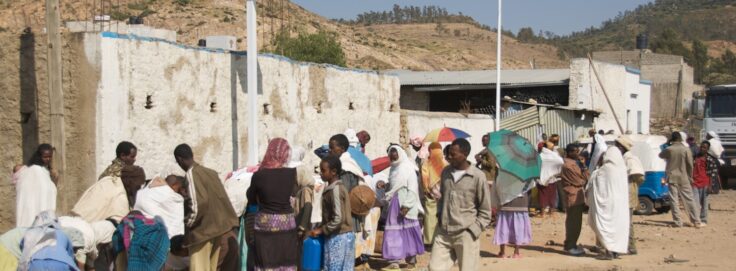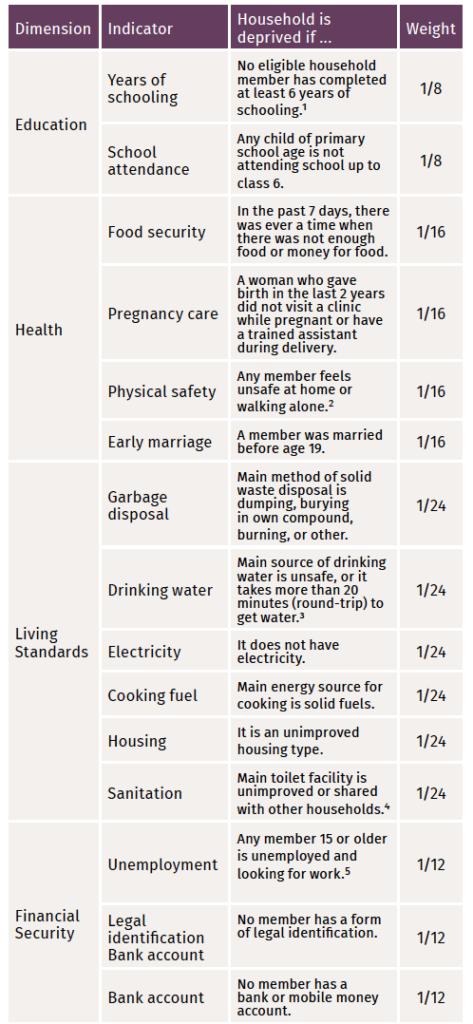
Search
The intersection of gender, forced displacement, and multidimensional poverty

Internally displaced persons (IDPs) disproportionately suffer chronic deprivations, such as food insecurity, temporary housing, and limited access to services and employment. Women and girls in forced displacement also face increased vulnerabilities, including greater health and gender-based violence risks than their male peers. To evaluate the intersection of forced displacement, multidimensional poverty, and gender, we developed a gender-sensitive Multidimensional Poverty Index (MPI) for forcibly displaced populations in five Sub-Saharan African countries: Ethiopia, Northeast Nigeria, Somalia, South Sudan, and Sudan.
The MPI measures deprivations with 15 indicators across four dimensions (education, health, living standards, and financial security) and diverges from the global MPI in two key ways. Firstly, some indicators differ. For health, we evaluate food security, early marriage, antenatal care, and physical safety, rather than nutrition and child mortality, and for living standards, we replace the assets indicator with the main method of garbage disposal. We also include a fourth dimension covering unemployment, legal identification, and bank account ownership.
Secondly, the poverty cutoff identifies those deprived in at least half of the weighted indicators as multidimensionally poor, rather than at least a third of the weighted indicators, as is the case with the global MPI.
Our results show that forcibly displaced communities are poorer than host communities in all five countries, although the most salient indicator differs by country. Among the poor in Ethiopia, deprivations are highest for displaced communities in bank account ownership and cooking fuel; in Nigeria, legal identification; in Somalia, years of schooling; in South Sudan, drinking water; and in Sudan, electricity.
We also find that female-headed households are poorer than male-headed households in most countries, and that displaced female-headed households are poorer than their non-displaced counterparts.
Generally, we observe that displacement affects a household’s poverty status, whereas gender affects intrahousehold inequality, and that among the multidimensionally poor, children in displaced households – and especially girls – face greater barriers to educational equity than their non-displaced peers.
These educational findings predate the global pandemic and highlight potential long-term repercussions of school closures both for the generation already out-of-school and for the children who recently became deprived in school attendance.
Overall, our findings reinforce the need to unpack headline MPI findings at lower levels, be it within the household or across geographic regions, to best inform policymakers where to deploy targeted, evidence-based anti-poverty interventions.
Written with Yeshwas Admasu, Sabina Alkire, Uche Eseosa Ekhator-Mobayode, Fanni Kovesdi, and Julieth Santamaria. Published as Admasu, Yeshwas; Alkire, Sabina; Scharlin-Pettee, Sophie. 2021. Multidimensional Poverty, Gender, and Forced Displacement: A Multi-Country, Intrahousehold Analysis in Sub-Saharan Africa. Policy Research Working Paper; No. 9823. World Bank, Washington, DC. ©World Bank. License: CC BY 3.0 IGO. Also published as Admasu, Y., Alkire, S. and Scharlin-Pettee, S. (2022). ‘Multidimensional poverty, gender, and forced displacement: A multi-country, intrahousehold analysis in Sub-Saharan Africa’, OPHI Working Paper 139, Oxford Poverty and Human Development Initiative (OPHI), University of Oxford.
1 Eligibility is determined by primary school starting age in the country. Those aged 6 years or older than the starting age are eligible. For starting age in each country, see UNESCO Institute for Statistics, Data for the Sustainable Development Goals.
2 A household is deprived if the respondent reports feeling moderately or very unsafe when alone at home, walking alone after dark, or walking around during the day. In Sudan, the indicator on the ‘feeling safe from crime and violence when at home’ was not available, and the indicator only considers answers to the questions on safety when walking alone.
3 Unprotected dug well, unprotected spring, carts with tank, tanker-truck, surface water, or other are considered as unsafe waters sources according to international guidelines. See the WHO/UNICEF, Joint Monitoring Programme, Drinking Water.
4 Pit latrine without slab, bucket, hanging toilet, no facility (open defecation) facilities are considered as unimproved sanitation facilities according to international guidelines. See the WHO/UNICEF, Joint Monitoring Programme, Sanitation.
5 According to the ILO definition, those who did not participate in employment in the last four weeks (and have no work to return to), are actively looking for work and are available to start, or those currently waiting to start work are classed as unemployed.
This article was published in Dimensions 14

















